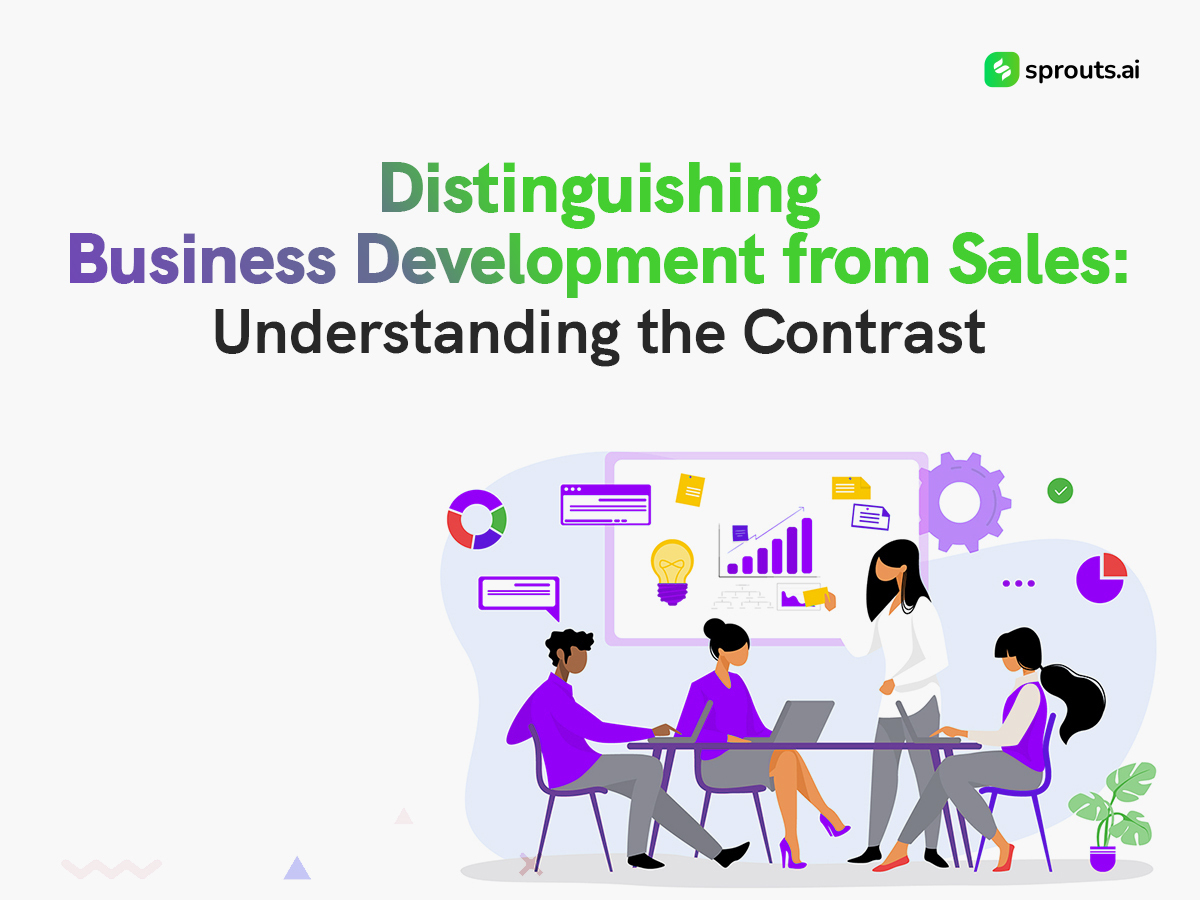Imagine a company as a mighty oak, its roots firmly planted, branches reaching for the sky. Business development and sales, like the sun and rain, nourish this oak in different ways, each crucial for its growth. While both contribute mightily to a company’s financial well-being, they operate in distinct ways. This blog post sheds light on the key differences between these two crucial functions, highlighting their contrasting approaches and underlining the significance of understanding this critical distinction. Let’s begin!
Defining Business Development and Sales
Let’s first start by defining both terms:
- Business Development: Business development focuses on the strategic planning and implementation of initiatives to expand a company’s reach, identify new opportunities, and foster growth. This encompasses a wide range of activities, including market research, partnership development, product innovation, and strategic planning. Business development professionals are tasked with building relationships, exploring new markets, and creating opportunities for the organization to expand its revenue streams.
- Sales: Sales, on the other hand, is the process of converting leads or prospects into customers by convincing them to purchase a product or service. Sales professionals are primarily concerned with closing deals and generating revenue. They utilize various techniques such as pitching, negotiation, and relationship building to persuade potential customers to make a purchase.
Understanding the Contrast
While both business development and sales play crucial roles in driving revenue growth, they operate at different stages of the customer acquisition process and focus on distinct objectives:
- Strategic vs. Tactical: Business development is strategic in nature, focusing on long-term growth opportunities and market expansion. Professionals in this field analyze market trends, identify potential partnerships, and develop strategies to penetrate new markets or launch innovative products. Sales, on the other hand, is more tactical, concentrating on immediate revenue generation through direct interactions with customers.
- Relationship Building vs. Transactional: Business development emphasizes relationship building and fostering partnerships that can lead to sustainable revenue streams over time. Business development professionals invest in cultivating long-term relationships with key stakeholders, including potential clients, strategic partners, and industry influencers. In contrast, sales transactions are often more transactional, with the primary goal of closing deals and generating immediate revenue.
- Focus on Value Creation: Business development focuses on creating value for both the company and its partners or clients. This may involve identifying synergies between organizations, exploring collaborative opportunities, or developing innovative solutions to address market needs. Sales, on the other hand, is more focused on demonstrating the value of the company’s products or services to individual customers and convincing them to make a purchase.
- Market Expansion vs. Revenue Generation: Business development aims to expand the company’s market presence by identifying new opportunities and entering untapped markets. This may involve exploring new geographic regions, targeting different customer segments, or diversifying the company’s product portfolio. Sales, on the other hand, is primarily concerned with generating revenue from existing products or services by converting leads into paying customers.
The Importance of Recognizing the Difference
Understanding the distinction between business development and sales is essential for several reasons:
- Strategic Planning: Recognizing the unique roles of business development and sales allows companies to allocate resources effectively and develop comprehensive growth strategies. By understanding the broader market landscape and identifying new opportunities, business development professionals can inform sales teams about potential growth areas and provide them with the necessary support and resources to succeed.
- Targeted Approach: Differentiating between business development and sales enables companies to adopt a targeted approach to customer acquisition and revenue generation. Business development efforts can focus on identifying high-potential opportunities and nurturing relationships with key partners, while sales teams can concentrate on converting qualified leads into paying customers.
- Optimized Resource Allocation: By understanding the distinct objectives of business development and sales, companies can optimize resource allocation and investment decisions. For example, if the goal is to enter a new market or develop a strategic partnership, business development efforts may require more significant upfront investments in research, networking, and relationship building. In contrast, sales initiatives may require more resources in terms of training, lead generation, and customer support.
- Long-Term Growth: Differentiating between business development and sales allows companies to focus on both short-term revenue generation and long-term growth opportunities. While sales efforts are essential for driving immediate revenue, business development activities lay the groundwork for sustained growth by identifying new markets, forging strategic partnerships, and developing innovative products or services.
Business development and sales are two distinct yet interconnected functions that play vital roles in driving revenue growth and fostering organizational success. While business development focuses on strategic planning, market expansion, and relationship building, sales is more tactical, concentrating on closing deals and generating immediate revenue. Recognizing the difference between these two functions is crucial for companies looking to develop comprehensive growth strategies, optimize resource allocation, and achieve sustainable long-term growth. By recognizing their distinct roles and fostering their collaborative power, companies can unlock a winning formula for sustainable growth.

